Housing needs of minority ethnic groups: evidence review
This report provides a review of the literature on the housing needs and experiences of minority ethnic groups in Scotland, and presents results of secondary data analysis. The research also identifies gaps in the evidence and suggests areas where further research could be useful.
2. Housing trends
2.1 Introduction
The minority ethnic population in Scotland is distinctive in terms of size, ethnic composition and patterns of settlement. The population includes Pakistanis, Chinese, Indians, Africans, Irish, Gypsy/Travellers, Polish, asylum seekers and refugees, and other communities. These groups are concentrated in the four main cities of Glasgow, Edinburgh, Aberdeen and Dundee but small numbers are present across Scotland, including the more remote areas of the Highlands and Islands (Netto et al. 2011).
The Scottish Government believes that a safe, secure, warm place to stay is the minimum that we should all expect (Scottish Government 2017a). However, there are indications that minority ethnic communities in Scotland and in the UK generally experience poorer housing outcomes than their white Scottish/British counterparts including: higher levels of overcrowding and higher rates of homelessness compared to the population as whole (Netto et al. 2011; Netto et al. 2001). Many people in these communities face a higher risk of poverty and in-work poverty, lower employment rates and under-representation in political and public life (Scottish Government 2017a). However, although levels of disadvantage may be higher within the minority ethnic population, not all groups experience this to the same extent and there can be considerable diversity within and between groups (Netto et al. 2011).
2.2 Policy context
The Race Equality Framework 2016-2030 (REF) sets out the Scottish Government's approach to promoting race equality and tackling racism and racial inequality between 2016 and 2030. The Framework is based on the priorities, needs and experiences of Scotland's minority ethnic communities and was drafted with input from the public and voluntary sectors and academia, to ensure that the Framework is practical and deliverable. The aim of the Framework is to create measurable progress on race equality (Scottish Government 2016a).
Following the publication of the REF, in 2016 an independent Race Equality Adviser was appointed to provide insight and advice on implementing the REF actions. The Adviser's report, Addressing Race Inequality in Scotland: The Way Forward[12], sets out several recommendations and actions which form the basis of the Race Equality Action Plan 2017-2021(REAP). The report recognised that the housing status of minority ethnic groups had remained static for some time and identified four areas of concern:
- access to social housing;
- housing quality improvements in the low value owner occupier and private
rented sector;
- housing advice services; and
- employment of minority ethnic people in housing services (Scottish Government 2017b)
Building on the recommendations from the Adviser's report, the Scottish Government's REAP sets out key actions for the current parliamentary session to drive positive change for minority ethnic groups in Scotland. It is set as part of the 15 year REF and informed by the work of the Race Equality Adviser. It is intended to play a key role in advancing race equality, tackling racism and addressing the barriers that prevent people from minority ethnic communities from realising their potential. Housing is a key area identified in the plan and it contains a number of actions in this area, upon which the aims of this report are based (Scottish Government 2017a).
In March 2020, the Race Equality Action Plan: two year progress update[13] was published, providing an interim update to stakeholders on progress made in the second year of the REAP (Scottish Government 2020b). The final update, providing a complete record against all actions in the REAP, is due in March 2021.
2.3 Population
There is limited up to date data on the size of the minority ethnic population in Scotland and what does exist often does not provide a detailed breakdown by ethnic group. Publications often use different groupings or aggregate data in inconsistent ways. For example, many studies refer to minority ethnic groups but exclude white minority ethnic groups, such as 'White Polish' and 'White Other', in quantitative estimates of the population.
The 2011 Census, although now dated, is the most comprehensive source of data available on the size and profile of the minority ethnic population, particularly in the Scottish context where numbers make up a relatively small proportion of the population. The Census indicates that the proportion of minority ethnic adults resident in Scotland grew from around 5% of the population in 2001 to 8% in 2011 (432,616 from the total Scottish adult population of 5,295,403). (National Records of Scotland 2016).
Due to the infrequency of the Census, and recognising that it is now nine years out of date, it is reasonable to assume that the proportion of the population who are from a minority ethnic background has risen further since the 2011 Census. As such, it is important to consider other sources. More recent analysis of the Scottish Survey Core Questions (SSCQ) offers an indication of how the population has changed since the last Census. It estimates that the minority ethnic population, including white minority ethnic groups and white Irish, now sits at between 10% and 12% of Scotland's population. However, the SSCQ does not provide a full breakdown of the population by ethnic sub-group (Scottish Government 2019a).
The 2011 Census indicates that the 'Asian' population is the largest minority ethnic group in Scotland, making up 2.7% of the population. The 'African' group makes up 0.6% of the population, while the 'Caribbean or Black' group makes up 0.1%. Mixed or multiple ethnic groups and other ethnic groups represent 0.4% and 0.3% respectively (Scottish Government 2015).
The proportion of the population reported as belonging to a minority ethnic group varied by local authority area (see Annex 1 for a full breakdown) but were concentrated in the major urban centres. The 2011 Census recorded 16% of the resident population in Aberdeen City and Edinburgh City; 15% of the population in Glasgow City and 10% of the population in Dundee as belonging to a minority ethnic group. Although the proportion of each ethnic group living in these areas varies. For example, 34% of all Asian minority ethnic adults resident in Scotland live in Glasgow (National Records of Scotland 2016). These results accord with SHS data which indicates that households with a minority ethnic HIH were more likely to live in a large urban area than households with a white British/Scottish HIH (Scottish Government 2020a).
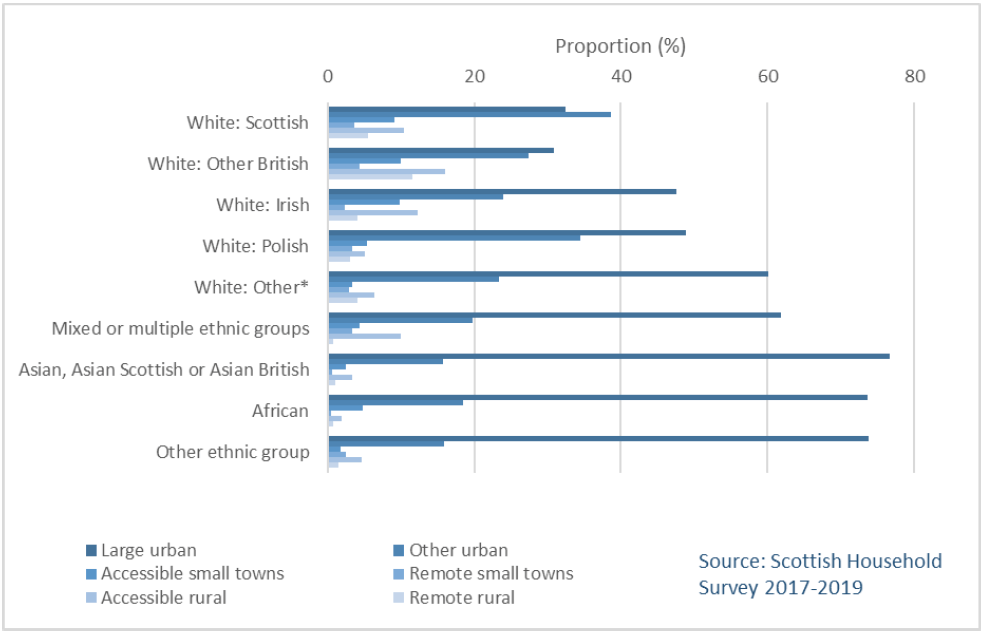
(White Scottish/British HIH Base: 29,150; Minority ethnic HIH Base: 2600)
2.4 Household composition and characteristics
2.4.1 Age
As shown in Figure 2, 2011 Census data shows that minority ethnic groups had younger age profiles than white Scottish/British groups, with 63%-85% of the minority ethnic population aged under 40 years compared to 47% of the 'White: Scottish population and 41% of the 'White: British'. This effect was most pronounced within the 'White Polish group where only 15% were aged 40 and over (National Records of Scotland 2016).
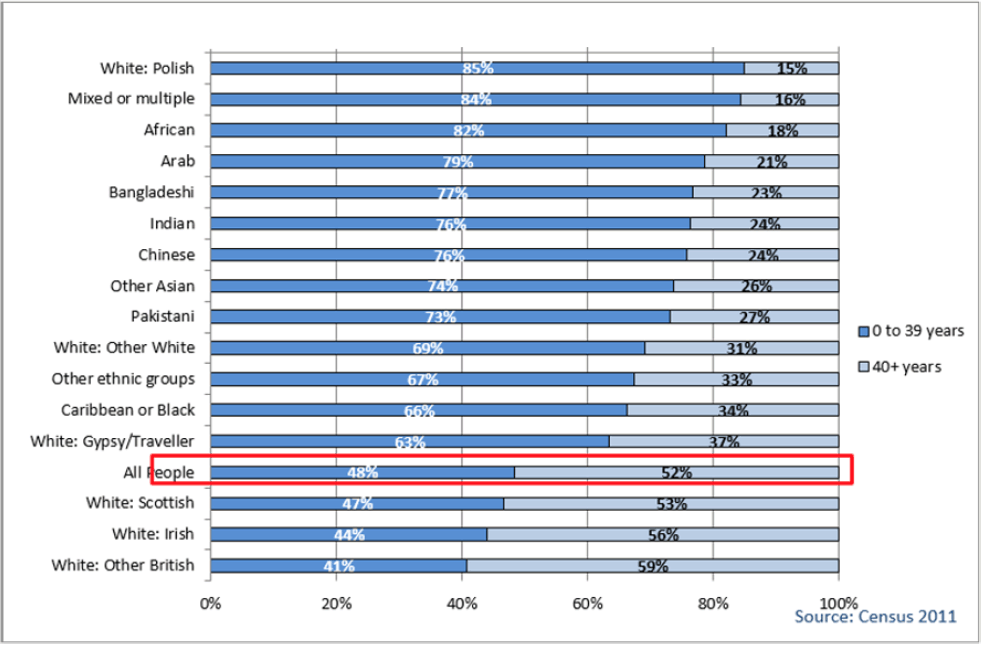
(Base, 5,295,403)
2.4.2 Gender
The proportion of males and females within the population differed according to ethnic group (see Table 1). In 2011, whilst 52% of the total population in Scotland identified as female and 48% male, the 'Arab' group was 58% male, and majority of the 'Bangladeshi', 'Indian', 'African', 'Pakistani' and 'Caribbean or Black' ethnic groups were also male. Conversely, the 'Other Asian', 'Other White', 'Chinese' and 'White: Scottish', groups had a slightly higher proportion of females compared with the population as a whole (National Records of Scotland 2016).
| Ethnicity | Male | Female |
|---|---|---|
| Arab | 58% | 42% |
| Other ethnic groups | 57% | 43% |
| Bangladeshi | 56% | 44% |
| Indian | 56% | 44% |
| African | 54% | 46% |
| Pakistani | 52% | 48% |
| Caribbean or Black | 52% | 48% |
| White: Polish | 51% | 49% |
| White: Other British | 50% | 50% |
| White: Gypsy/Traveller | 49% | 51% |
| White: Irish | 49% | 51% |
| Mixed or multiple | 49% | 51% |
| All People | 48% | 52% |
| White: Scottish | 48% | 52% |
| Chinese | 48% | 52% |
| White: Other White | 46% | 54% |
| Other Asian | 45% | 55% |
(Base, 5,295,403)
2.4.3 Family composition
Data from the 2011 Census shows that compared to white ethnic groups (excluding 'White: Polish') married couple families identifying as minority ethnic were generally more likely to have dependent children. This figure was highest in the 'African' group, where 76% of married couple families had dependent children, compared to 43% of the population as a whole. All minority ethnic groups, excluding those identifying as 'Indian' or 'Other ethnic group', were more likely than the population as a whole to live in lone parent households with dependent children. This finding was most pronounced in the 'Other Caribbean or Black group' where 91% of lone parent families had dependent children.
Figure 3 shows that larger households (containing three or more dependent children) were most common among the 'Pakistani' (36%), 'Arab' (32%) and 'Bangladeshi' (26%) ethnic groups, compared to 13% of the population as a whole and only 8% of the 'White: Polish' group. The 'White: Polish' group were most likely to have just one dependent child (62%) (National Records of Scotland 2016).
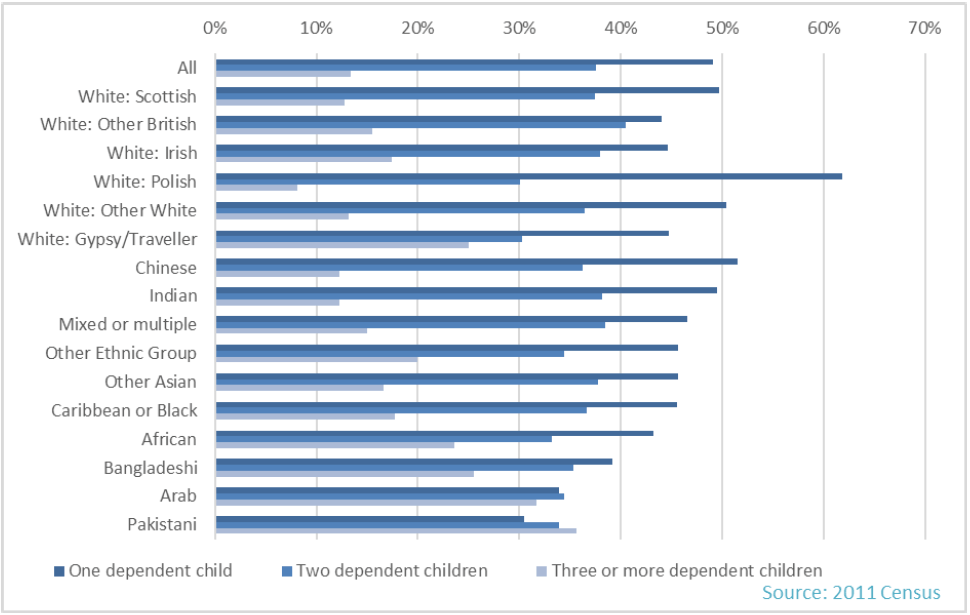
(Base: 616,489)
2.4.4 Tenure
Combined SHS data from 2017-2019 indicates that minority ethnic HIH households were more likely to be living in the private rented sector (PRS) than white Scottish/British HIH households. However, as Figure 4 shows, the proportion of those living in the PRS varies by ethnic group (Scottish Government 2020a). For example, the 'White: Other' group reported the highest levels of private renting. Within this group, 50% of households were private renting, with 15% social renting and 34% in the owner occupied sector. With the exception of the 'White: Irish' group where around a quarter were living in the PRS, around a third of all other minority ethnic groups were private renting.
Minority ethnic groups, with the exception of the 'African' group, were less likely to be in the social rented sector than in other tenures. Within the 'African' group, 45% were social renting, compared to 35% 'White: Polish', 15% 'White: Other', 15% 'Mixed or multiple ethnic group', 12% of 'Asian, Asian Scottish or Asian British' and 28.8% of the 'Other ethnic group'. This compared to 25% of 'White: Scottish' households and 12% of 'White: Other British' households (Scottish Government 2020a).
All minority ethnic groups were less likely to be owner occupiers than white Scottish/British with the exception of 'White: Irish' households. This trend was most pronounced within the 'African' group, where only 22% were living in the owner occupied sector, compared to 63% of 'White: Scottish' and 69% of 'White: Other British' households. Among the minority ethnic groups, the 'Asian, Asian Scottish or Asian British' group had the highest rate of owner occupation (50%). This compared to 29% of 'White:Polish' households, 36% 'White:Other', 42.3% 'Mixed or multiple ethnic group' and 29% 'Other ethnic group' (Scottish Government 2020a).
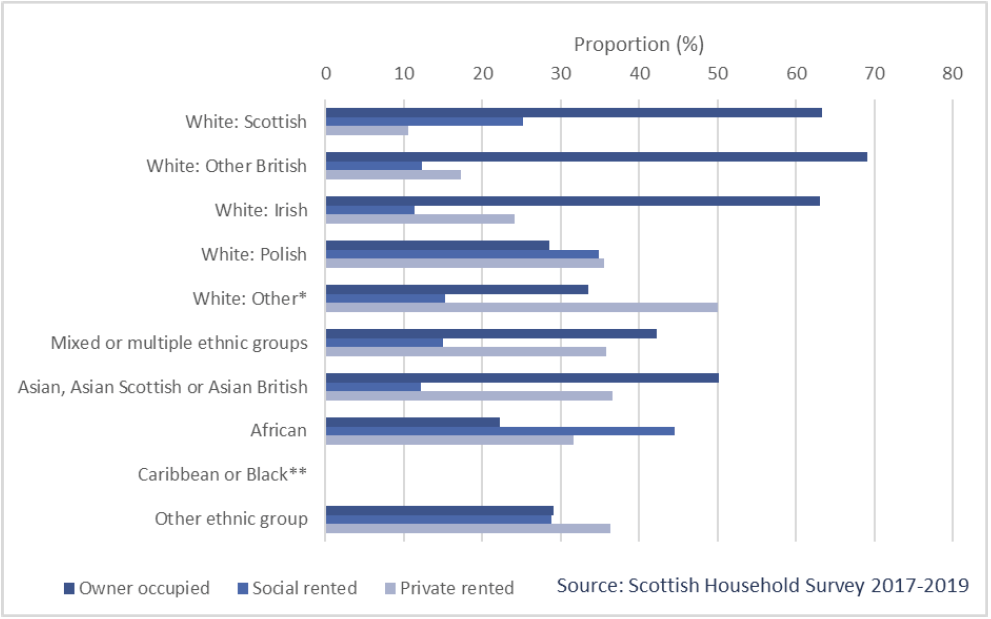
(White Scottish/British HIH Base: 29,150; Minority ethnic HIH Base: 2600)
2.4.5 English language proficiency
In terms of language proficiency, minority ethnic groups generally reported lower levels of spoken English compared to white Scottish/British or Irish groups. As shown in Figure 5, the 'Chinese' and 'White: Polish' groups reported the lowest levels of spoken English proficiency (National Records of Scotland 2016).
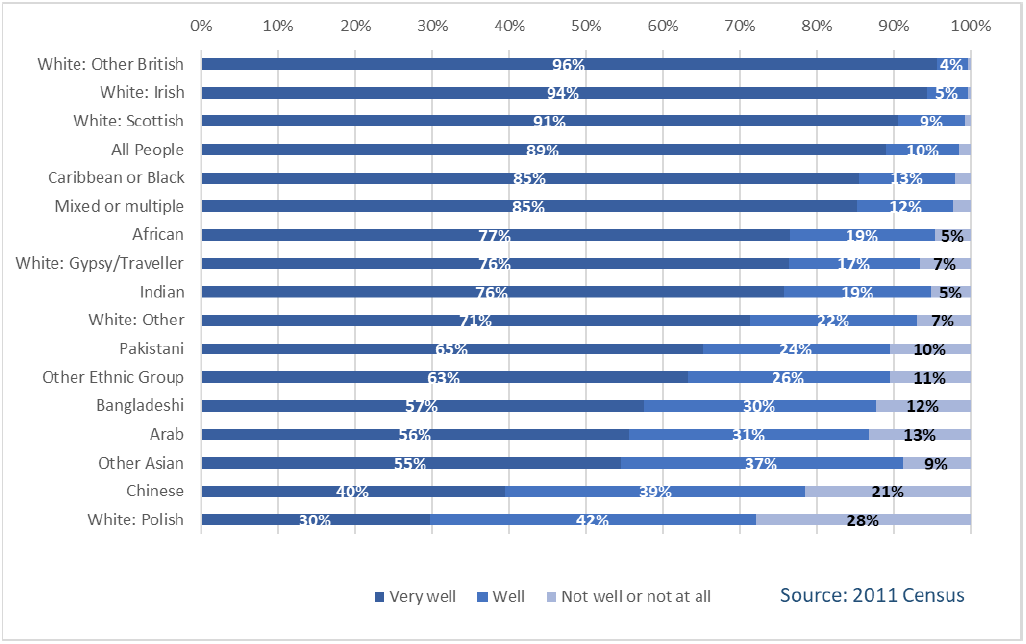
(Base 5,295,403)
2.4.6 Health
According to combined SHS data from 2017-2019, households with a non-white minority HIH were much less likely to have at least one person with a physical or mental health condition or illness than households with a white HIH (see Table 2).
| Ethnicity | No | Yes |
|---|---|---|
| White | 59.4% | 40.6% |
| Mixed or multiple ethnic group | 74.5% | 25.5%% |
| Asian, Asian Scottish or Asian British | 79.6% | 20.4% |
| African | 81.5% | 18.5% |
| Caribbean or Black | * | * |
| Other ethnic group | 77.4% | 22.6% |
(Base 31,790)
A "*" indicates where data has been suppressed due to small sample sizes.
Of 31,790 sampled, 40.6% of households with a white HIH had at least one person with a physical or mental health condition or illness compared to 25.5% of 'Mixed or multiple', 20.4% of 'Asian, Asian Scottish or British', 18.5% of 'African' and 22.6% of the 'Other' group (Scottish Government 2020a). Data from the SSCQ 2018 accords with this, where minority ethnic groups were less likely to report that they were living with a limiting long-term physical or mental health condition than their white Scottish/British counterparts (Scottish Government 2019a). It has been noted that these lower levels may, in part, be attributable to the younger age profile of some minority ethnic groups (as shown in section 2.4.1) (Scottish Government 2014).
2.4.7 Poverty and deprivation
Data published by the Scottish Government in 2020, based on five year averaged estimates from the Family Resources Survey indicates that in 2014-19, people from non-white minority ethnic groups were more likely to be living in relative poverty[14] compared to those from the 'White - British' group, both before and after housing costs. Figure 6 shows that all minority ethnic groups, including 'White – Other', were more likely to be living in relative poverty compared to the 'White – British' group when housing costs were taken into account. In this analysis 'White Scottish' and 'White British' were combined into the category 'White – British' (Scottish Government 2020c).
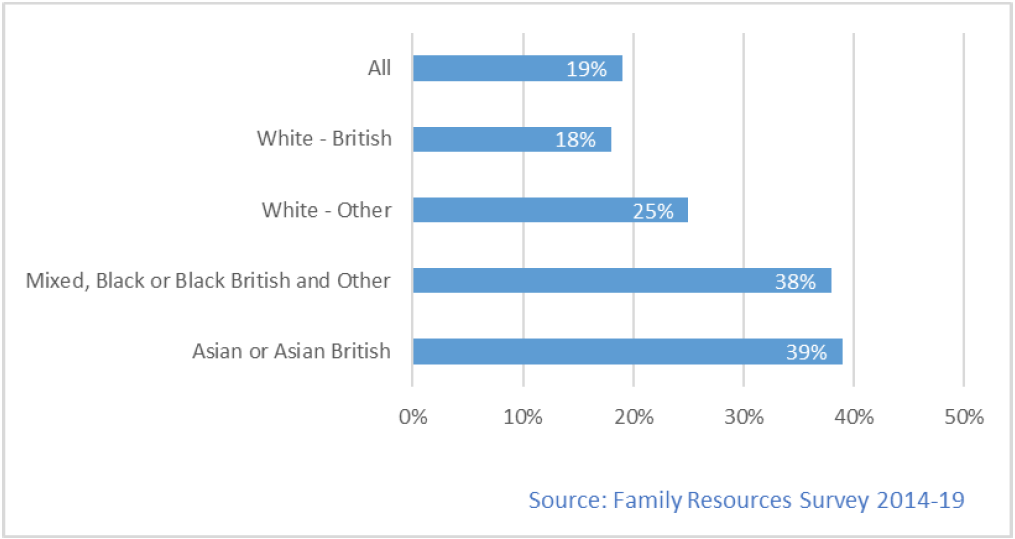
(Base: 940)
It is worth noting that this analysis does not account for differences in the age profiles of ethnic groups. Older people have been shown to have a lower poverty rate and, given the older age profile of the 'White - British' population in Scotland, (see section 2.4.1) this may partly explain the lower poverty rate for this group (Scottish Government 2020c). However, differences in age profiles cannot account for the entire gap in poverty rates between ethnic groups (Scottish Government 2020c). An additional caveat is that, due to the small sample sizes of ethnic sub-groups, the measurement of uncertainty will be relatively large (Scottish Government 2020c).
Secondary analysis of combined Scottish House Condition Survey (SHCS)[15] data from 2016-2019 indicates that a statistically similar proportion of households with a minority ethnic HIH were living in fuel poverty compared to households with a white Scottish/British HIH (see Figure 7). Analysis indicates that 27% of households with a minority ethnic HIH were found to be living in fuel poverty[16] and 13% were found to be extremely fuel poor, compared to 25% and 12%% respectively of households with a white Scottish/British HIH. For this analysis, data was combined over several years and only represents the ethnicity of the HIH (Scottish Government 2020d).
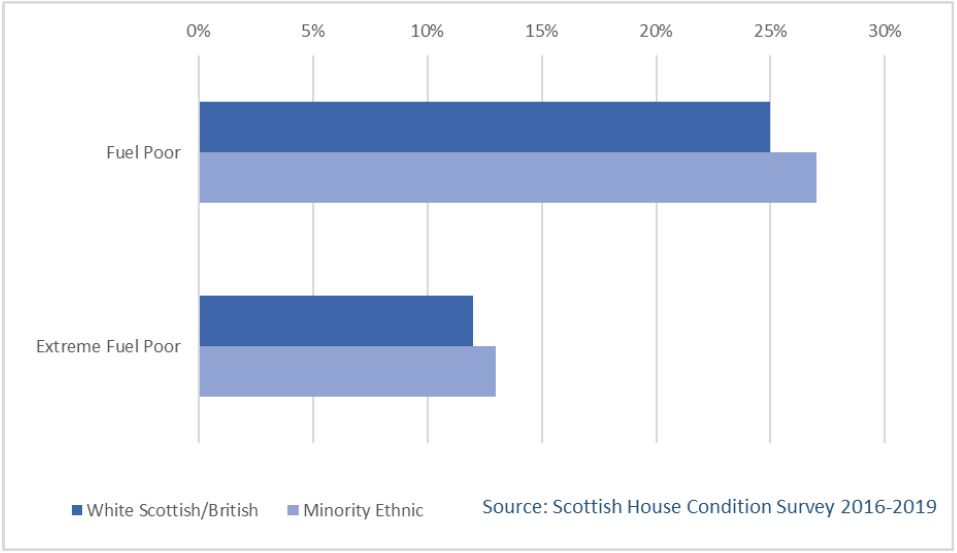
(White Scottish/British HIH Base: 10,772; Minority ethnic HIH Base: 819)
Combined SHS data from 2017-2019 indicates that some minority ethnic groups are disproportionately living in deprived areas in Scotland (see Figure 8). These figures indicate that households with an 'African' HIH were more than three times as likely to be living in the 10% most deprived areas in Scotland than 'White: Scottish' HIH households, 35% compared to 11% respectively. Households where the HIH was 'White: Polish' or from the 'Other ethnic' group were also considerably more likely to be living in the 10% most deprived areas, with 20% of each of households from these groups living in these areas. Households where the HIH was from the 'White: Other' group were the least likely of minority ethnic HIH households to be living in the 10% most deprived areas, with 9% of households from this group living in these areas (Scottish Government 2020a).
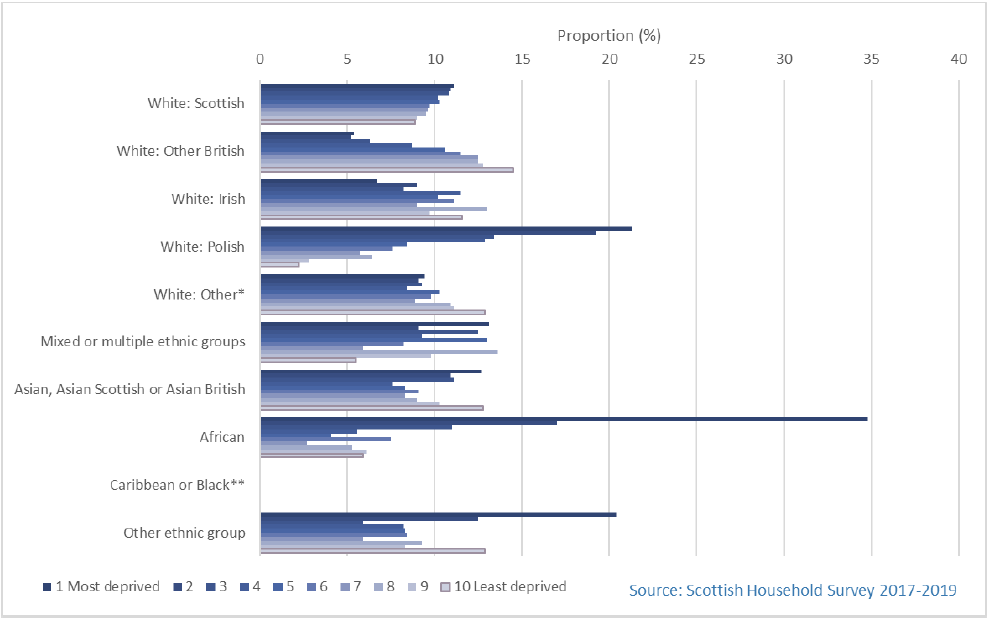
(White Scottish/British HIH Base: 10,772; Minority ethnic HIH Base: 819)
2.4.8 Students
A greater proportion of the minority ethnic population in Scotland is made up of students than the white Scottish/British population. Data from the SHS, combined over the years 2017-2019, found that depending on ethnic group, between 4%-19% of households with a minority ethnic HIH contained residents in further or higher education, compared to 1.5% of households with a 'White: Scottish' HIH and 3.4% of households with a 'White: Other British' HIH (Scottish Government 2020a). Whilst disaggregated data for white ethnic sub-groups is not available by economic activity in the Census, analysis found that 21%% of non-white minority ethnic groups were defined as economically-inactive students in 2011 (National Records of Scotland 2016).
Further analysis is also available in the random adult component of the SHS. Of 900 students in the sample, 32% were from a minority ethnic background and of these, 72% were mature students[17]. This compared to 68% of students in the sample who were from a white Scottish/British background, where just under half (46%) were mature students. Among minority ethnic students, private renting was the most common tenure by a large margin (75%), 14% were owner occupiers and 10% were social renting (see Figure 9). This compared to 38% of white Scottish/British students living in private rented accommodation, with 40% in the owner occupied sector and 19% social renting.
Among minority ethnic mature students a large proportion rented privately (81%), while 10% were owner occupiers and 7% lived in social rented accommodation. This compared to 43% of white Scottish/British mature students renting privately, 34% in owner occupation and 19% social renting (Scottish Government 2020a).
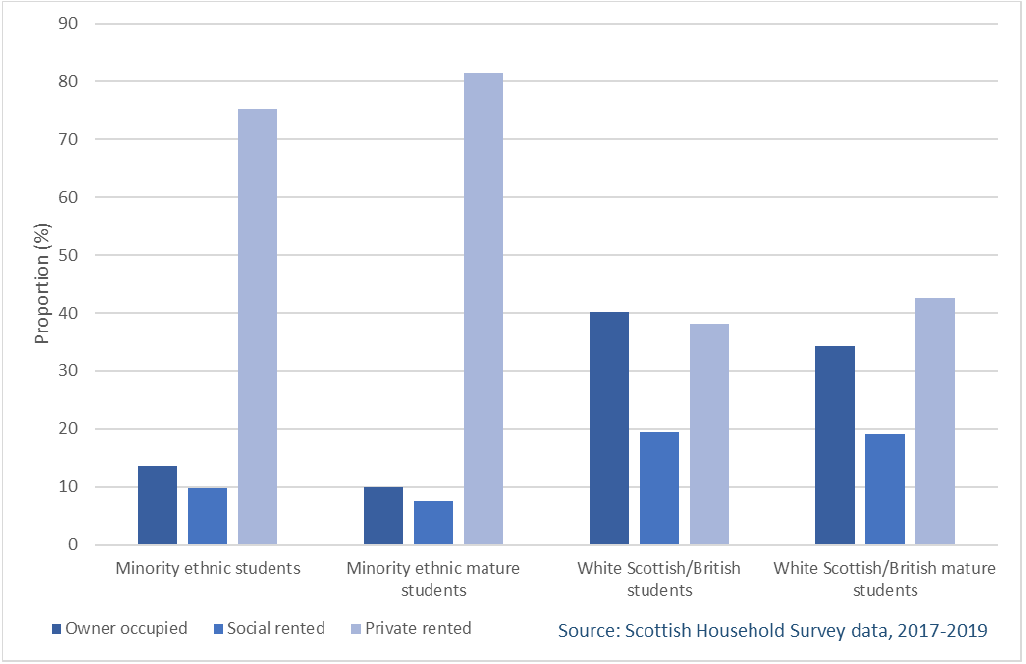
(White Scottish/British HIH Base: 610; Minority ethnic HIH Base: 290)
2.4.9 Asylum seekers and refugees
The Home Office publishes quarterly data on asylum, which includes the number of asylum seekers in Scotland. Section 95 of the Immigration and Asylum Act 1999[18] entitles those seeking asylum to accommodation and subsistence support, or subsistence support only, if they would otherwise be destitute. Data published up to June 2020 showed that there were 3,844 people in receipt of Section 95 support in Scotland, of which 3,798 were in Glasgow (Home Office 2020). Accommodation support under Section 95 is provided through regional accommodation contracts in asylum dispersal areas throughout the UK (Scottish Government 2018). Since this approach was established in 1999, Glasgow has been the only dispersal area in Scotland (Scottish Government 2018). Asylum seekers have no recourse to public funds, meaning they cannot access local authority housing or homelessness services (Scottish Government 2018).
In addition to those receiving Section 95 support, there are also smaller numbers of people receiving support under Section 98 (for those who appear to be destitute and are awaiting Section 95 support) and Section 4 (for those who have been refused asylum) of the Immigration and Asylum Act 1999 (Home Office 2020). Numbers receiving this kind of support are not broken down by local authority, so it is unclear how many people are in receipt of this support in Scotland.
It is difficult to ascertain how many people who have been granted some form of refugee status or humanitarian protection in the UK have chosen to live in Scotland. Once their status has been granted, a person with refugee status can decide where in the country they wish to live (Scottish Government 2017). Most general datasets do not identify refugees and asylum seekers, so other than the numbers of asylum seekers claiming support there is little data available (Scottish Government 2018). In many cases this is due to the lack of a necessity to record refugee status as it is not a protected characteristic in itself and as such, it is not captured as part of equality data. This means that this data usually goes unrecorded unless it is within the context of a specific project or programme (Scottish Government 2019b).
2.5 Discrimination
Racial crime was the most commonly reported hate crime[19] in Scotland in 2019-20. In this period, the number of reported racial crimes rose by 4% from the previous year, however it is noted that there has been an overall decrease in reported charges since 2010-11 (Crown Office and Procurator Fiscal Service 2020). These findings accord with data from the Scottish Social Attitudes Survey 2015[20], which indicates that, at the time of the survey, a sizeable proportion of the population held prejudiced attitudes towards those from a minority ethnic background. Of 1288 people surveyed, around a fifth of people felt that there was sometimes a good reason to be prejudiced and just over a third believed that Scotland would begin to lose its identity if more Black and Asian people came to live in Scotland, while a similar proportion believed the same about Eastern European migration (Scottish Government 2016b).
Research from the Runnymede Trust in England and Wales, found that over a quarter of Black Caribbean (29%), 28% of Black African and 27% of Pakistani respondents felt discriminated against when trying to access private housing, compared to 1% of white British respondents. Whilst equivalent research for Scotland is lacking, there is evidence that minority ethnic groups in Scotland face appreciable levels of discrimination and harassment and there are indications that this is under-reported (EHRC 2018; BEMIS 2016; EHRC 2016; Meer 2015).
Contact
There is a problem
Thanks for your feedback